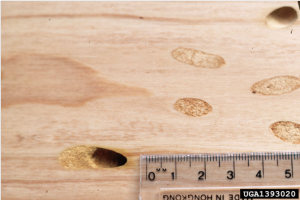
The names “wood wasp” and “horntail” describe several kinds of wood-boring insects in the Order Hymenoptera, Family Siricidae. Of greatest concern are the large, non-stinging wasps that are attracted to and complete their life cycles in newly dead or dying conifer trees. If timber is salvaged from these trees, adult wasps may emerge from infested lumber in recently completed structures (see Figure 1).

Figure 1. Wood sawn from a tree damaged by Sirex noctilio (Photo by Dennis Haugen, Bugwood.org).
There are several species of horntails, all looking very similar. They are large wasps, generally 1 inch or longer. They have a wasplike appearance but lack a noticeable constriction in the abdomen, as seen with many wasps. They are often black or metallic dark blue or combinations of black, red, and yellow.
The male and female have a similar body shape, except the female is larger and has a very prominent ovipositor. The female can use her ovipositor only for egg laying; she can’t use it to sting in defense.
The female drills her ovipositor nearly 3/4” into the wood of a weakened or dying tree and lays 1 to 7 eggs.
She may lay up to 200 eggs in her lifetime. Eggs hatch in 3 to 4 weeks, and larvae tunnel into the wood parallel with the grain. Larval feeding continues through 5 or more immature stages, which take at least a year and as many as 5 years in cooler climates to complete. The tunnel, or gallery, usually measures 10 to 12 inches long at completion.
Pupation takes place at the end of the gallery. After 5 or 6 weeks as a pupa, the adult emerges by chewing through about 3/4” of wood, leaving a round exit hole 1/4” – 1/2” diameter.
Although they can be extremely annoying, and can look intimidating to many people, horntails are not harmful to humans or structures. They only attack trees and won’t bore into wood in buildings or furniture, and therefore, will not re-infest structures. Fortunately, the damage is more cosmetic and does not cause any real structural damage. The only real management strategy would be to repair or replace any cosmetic damage.

